with的复合结构
- 格式:doc
- 大小:32.00 KB
- 文档页数:3
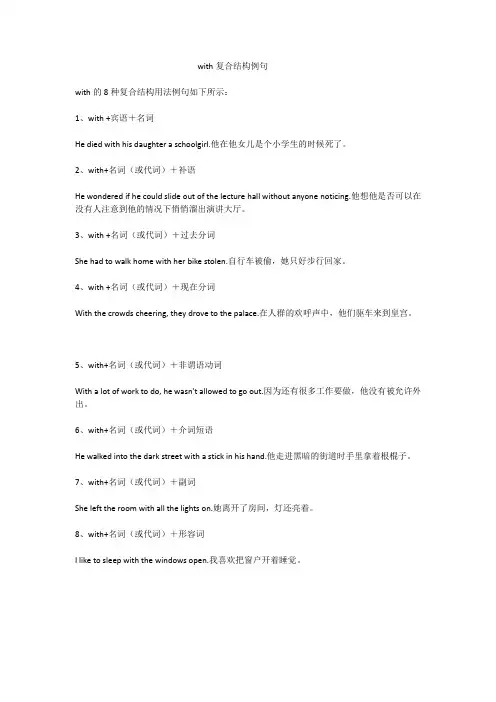
with复合结构例句
with的8种复合结构用法例句如下所示:
1、with +宾语+名词
He died with his daughter a schoolgirl.他在他女儿是个小学生的时候死了。
2、with+名词(或代词)+补语
He wondered if he could slide out of the lecture hall without anyone noticing.他想他是否可以在没有人注意到他的情况下悄悄溜出演讲大厅。
3、with +名词(或代词)+过去分词
She had to walk home with her bike stolen.自行车被偷,她只好步行回家。
4、with +名词(或代词)+现在分词
With the crowds cheering, they drove to the palace.在人群的欢呼声中,他们驱车来到皇宫。
5、with+名词(或代词)+非谓语动词
With a lot of work to do, he wasn't allowed to go out.因为还有很多工作要做,他没有被允许外出。
6、with+名词(或代词)+介词短语
He walked into the dark street with a stick in his hand.他走进黑暗的街道时手里拿着根棍子。
7、with+名词(或代词)+副词
She left the room with all the lights on.她离开了房间,灯还亮着。
8、with+名词(或代词)+形容词
I like to sleep with the windows open.我喜欢把窗户开着睡觉。


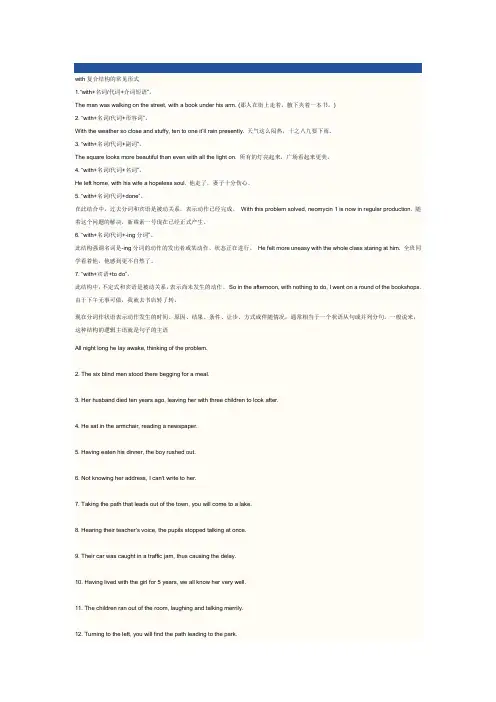
with复合结构的常见形式1.“with+名词/代词+介词短语”。
The man was walking on the street, with a book under his arm. (那人在街上走着,腋下夹着一本书。
)2. “with+名词/代词+形容词”。
With the weather so close and stuffy, ten to one it’ll rain presently. 天气这么闷热,十之八九要下雨。
3. “with+名词/代词+副词”。
The square looks more beautiful than even with all the light on. 所有的灯亮起来,广场看起来更美。
4. “with+名词/代词+名词”。
He left home, with his wife a hopeless soul. 他走了,妻子十分伤心。
5. “with+名词/代词+done”。
在此结合中,过去分词和宾语是被动关系,表示动作已经完成。
With this problem solved, neomycin 1 is now in regular production. 随着这个问题的解决,新霉素一号现在已经正式产生。
6. “with+名词/代词+-ing分词”。
此结构强调名词是-ing分词的动作的发出者或某动作、状态正在进行。
He felt more uneasy with the whole class staring at him. 全班同学看着他,他感到更不自然了。
7. “with+宾语+to do”。
此结构中,不定式和宾语是被动关系,表示尚未发生的动作。
So in the afternoon, with nothing to do, I went on a round of the bookshops. 由于下午无事可做,我就去书店转了转。
现在分词作状语表示动作发生的时间、原因、结果、条件、让步、方式或伴随情况,通常相当于一个状语从句或并列分句。


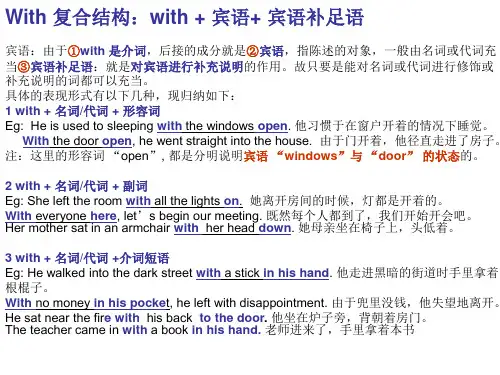

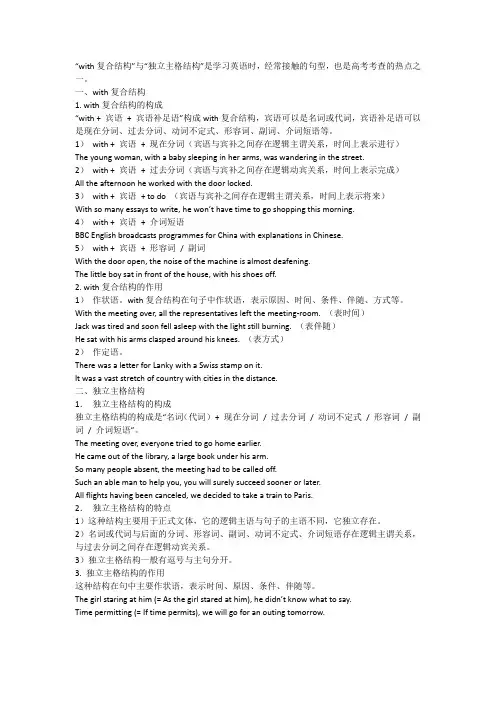
“with复合结构”与“独立主格结构”是学习英语时,经常接触的句型,也是高考考查的热点之一。
一、with复合结构1. with复合结构的构成“with + 宾语+ 宾语补足语”构成with复合结构,宾语可以是名词或代词,宾语补足语可以是现在分词、过去分词、动词不定式、形容词、副词、介词短语等。
1)with + 宾语+ 现在分词(宾语与宾补之间存在逻辑主谓关系,时间上表示进行)The young woman, with a baby sleeping in her arms, was wandering in the street.2)with + 宾语+ 过去分词(宾语与宾补之间存在逻辑动宾关系,时间上表示完成)All the afternoon he worked with the door locked.3)with + 宾语+ to do (宾语与宾补之间存在逻辑主谓关系,时间上表示将来)With so many essays to write, he won’t have time to go shopping this morning.4)with + 宾语+ 介词短语BBC English broadcasts programmes for China with explanations in Chinese.5)with + 宾语+ 形容词/ 副词With the door open, the noise of the machine is almost deafening.The little boy sat in front of the house, with his shoes off.2. with复合结构的作用1)作状语。
with复合结构在句子中作状语,表示原因、时间、条件、伴随、方式等。
With the meeting over, all the representatives left the meeting-room. (表时间)Jack was tired and soon fell asleep with the light still burning. (表伴随)He sat with his arms clasped around his knees. (表方式)2)作定语。
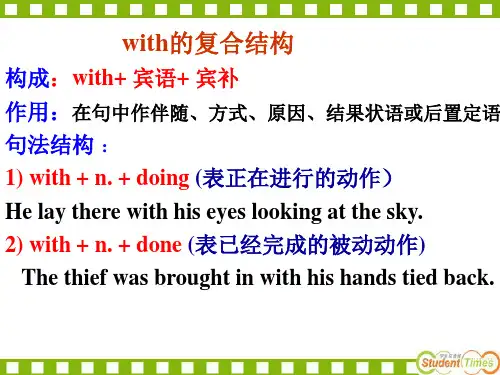

with复合结构with复合结构是由with+复合宾语组成,常在句中做状语,表示谓语动作发生的伴随情况、时间、原因、方式等。
其构成有下列几种情形:1 with + 名词(或代词) + 现在分词,此时,现在分词和前面的名词或代词是逻辑上的主谓关系。
例如:With prices going up so fast, we can't afford a car.(原因状语)With the crowds cheering, they drove to the palace. 在人群的欢呼声中,他们驱车来到皇宫。
(伴随情况)2 with + 名词(或代词) + 过去分词,此时,过去分词和前面的名词或代词是逻辑上的动宾关系。
例如:I sat in my room for a few minutes with my eyes fixed on the ceiling. 我在房间坐了一会儿,眼睛盯着天花板。
(伴随情况)She had to walk home with her bike stolen. 自行车被偷,她只好步行回家。
(原因状语)3 with + 名词(或代词) + 动词不定式,此时,不定式表示将发生的动作。
例如:With no one to talk to, John felt miserable. 由于没人可以说话的人,约翰感到很悲哀。
(原因状语)With a lot of work to do, he wasn't allowed to go out. 因为还有很多工作要做,他没有被允许外出。
(原因状语)4 with + 名词(或代词) + 形容词I like to sleep with the windows open. 我喜欢把窗户开着睡觉。
(伴随情况)With the weather so close and stuffy, ten to one it'll rain presently. 大气这样闷,十之八九要下雨。
With的复合结构With复合结构,是由with+宾语+宾补组成,在句中常做状语,如伴随、时间、原因、方式状语等,也可以做定语。
1.with+名词(或代词)+名词there is a tallng am “B s H s ”.B g s a s r.他们住在北京,他们的儿子是个士兵。
2) He died s a a s -girl.他去逝时,女儿还是个小学生。
3) He lived a rich life, s a a a .他过着富足的生活,而他的老父亲却沿街乞讨。
2.with+名词(或代词)+形容词强调名词的特性或状态She came into the room,with her nose red a s e of cold.1s open.我喜欢把窗户开着睡觉。
(伴)2) D ’ a with your mouth full.嘴里有食物时不要讲话。
(伴)3.with+名词(或代词)+副词With the meal over ,we all went home.a with the light on.他睡着了,灯还亮着。
(伴)2) The boy stood there with his head down.这个男孩低头站在那儿。
(伴)4.with+名词(或代词)+介词短语Do you know the woman with a baby in her arms(=who has ababy in her arms)?a a a a a on when we want to.由于孩子们在上学,所以当我们想度假时而不能去度假。
(原)a a a a .士兵让他背朝着他的父亲站在那儿。
(方)5.with+名词(或代词)+动词不定式此时,不定式表示将发生的动作。
With the boy to lead the way,we will find the house easm ow.1) With no one to talk to, John felt upset.由于没人可以说话的人,约翰感到很焦虑。
基本用法
它是由介词with或without+复合结构构成,复合结构作介词with或without的复合宾语,复合宾语中第一部分宾语由名词或代词充当,第二部分补足语由形容词、副词、介词短语或非谓语动词充当
一、with或without+名词/代词+形容词
例句:1.I like to sleep with the windows open.
我喜欢把窗户开着睡觉。
(伴随情况)
2.With the weather so close and stuffy, ten to one it'll rain presently.
大气这样闷,十之八九要下雨(原因状语)
二、with或without+名词/代词+副词
例句:1.She left the room with all the lights on.
她离开了房间,灯还亮着。
(伴随情况)
2.The boy stood there with his head down.
这个男孩低头站在那儿。
(伴随情况)
三、with或without+名词/代词+介词短语
例句:1.He walked into the dark street with a stick in his hand.
他走进黑暗的街道时手里拿着根棍子。
(伴随情况)
2. With the children at school, we can't take our vacation when we want to.
由于孩子们在上学,所以当我们想度假时而不能去度假。
(原因状语)
四、with或without+名词/代词+非谓语动词
1、with或without+名词/代词+动词不定式,此时,不定式表示将发生的动作。
例句: 1.With no one to talk to, John felt miserable.
由于没人可以说话的人,约翰感到很悲哀。
(原因状语)
2. With a lot of work to do, he wasn't allowed to go out.
因为还有很多工作要做,他没有被允许外出。
(原因状语)
2、with + 名词(或代词) + 现在分词,此时,现在分词和前面的名词或代词是逻辑上的主谓关系。
例句: 1.With prices going up so fast, we can't afford luxuries.
由于物价上涨很快,我们买不起高档商品。
(原因状语)
2. With the crowds cheering, they drove to the palace.
在人群的欢呼声中,他们驱车来到皇宫。
(伴随情况)
3、with + 名词(或代词) + 过去分词,此时,过去分词和前面的名词或代词是逻辑上的动宾关系。
例句: 1.I sat in my room for a few minutes with my eyes fixed on the ceiling.
我在房间坐了一会儿,眼睛盯着天花板。
(伴随情况)
2.She had to walk home with her bike stolen. 自行车被偷,她只好步行回家。
(原因状语)
五、with或without+名词/代词+补语
例句:1.Possibly this person died without anyone knowing where the coins were hidden.
有可能,这个人死的时候还没有人知道那些钱币被藏在哪里。
2.He wondered if he could slide out of the lecture hall without anyone noticing (him).
他想他是否可以在没有人注意到他的情况下悄悄溜出演讲大厅
3、with the winter coming
随着冬天的来临
※with+不定式和+分词的区别:
加不定式是指将要进行的动作,加分词是指主动或被动动作.
六、with +宾语(名词,代词)+名词
例句:1.He died with his daughter a schoolgirl
他在他女儿是个小学生的时候死了
句法功能
一、with 复合结构,在句中表状态或说明背景情况该结构常做伴随、方式、原因、条件等状语。
例句:1、With machinery to do all the work, they will soon have got in the crops.
由于所有的工作都是由机器进行,他们将很快收完庄稼。
(原因状语)
2、The boy always sleeps with his head on the arm.
这个孩子总是头枕着胳膊睡觉。
(伴随状语)
3、The soldier had him stand with his back to his father.
士兵要他背对着他父亲站着。
(方式状语)
4、With spring coming on, trees turn green.
春天到了,树变绿了。
(时间状语)
二、with 复合结构可以作定语
例句:Anyone with its eyes in his head can see it's exactly like a rope.
任何一个头上长着眼睛的人都能看出它完全像一条绳子。
三、like+名词/代词+补语
例句:1、The old pinetree still stood there like an umbrella covering the entrance of the cave.
这颗老松树依然耸立在那,像伞一样盖住了洞穴
2、The noise sounded like a train going under my house.
这声音听起来像是一列火车在我的屋子下面经过一样。